UNE SAISON EN ENFER: Holodomor, hell on earth
And this is still life! What an eternal damnation!
Arthur Rimbaud
Through a daily confrontation with Ukrainian misery and Putin’s madness, the mood oscillates between fuitile anger and helpless hopelessness. What is the fundamental fault of humanity? How can any sensible person imagine that a war of aggression could cause anything but sorrow and devastation? How is it possible that great nations can submit to the will of a single individual? And what might be said about Putin’s defense of the grotesque abuses he and his henchmen are guilty of? To demilitarize and de-Nazify Ukraine? An insult to an entire people. That Ukrainians are carrying out genocide on Russians? In a nation where Russians, Ukrainians, Roma/Sinti and Jews have been subjected to what Putin now baselessly accuses their descendants of and to which they were in fact subjected to by representatives of the regime to which he is the actual heir. That he, Putin the Great, is a knight in shining armour who in the name of the Holy Mother Russia is taking up arms against morally corrupting influences from the West. That this preposterous clown is rescuing Russians from Ukrainian evil. O Sancta Simplicitas! A warlock spinning a web of deadly illusions that now are becoming materialized in the shape of war and terror.


Several parallels have been drawn between the beginning of World War II and Putin’s cynical, armed attack on Ukraine. Not least the West’s shameful way of throwing Czechoslovakia into the Nazi throat for the sake of its own peace of mind. Not to mention the German army’s unprovoked Blitzkrieg against Poland, an unprovoked attack that finally triggered the entire World War II.


At four in the morning on September 1, 1939, German bombs began without any warning to fall on the Polish city of Wielún. It was an experiment – was it possible to wipe out all defences in a short time by terror-bombing a vulnerable civilian population? Seventy tons of bombs were dropped on the defenbceless city, people fled and when German ground troops arrived there were more corpses than people among the ruins. The next day, the action was repeated over 158 Polish settlements. On the tenth of September, Warsaw was subjected to seventeen bomb raids, and so it continued until the middle of the month when the metropolis, as the first major European city to be subjected to something similar, was destroyed and the defense ceased – this after 560 tons of ”conventional” bombs, and 72 tons of “firebombs” had been raining down on Warsaw, leaving 25,000 deaths. However, in the rest of the country the Poles continued to fight on, all alone. Poland never surrendered, neither to the Germans, nor to the Russians.
Admittedly, Britain and France had declared war on Germany, though apart from the French army invading the Saar, only to retreat after a short time, no military operations were carried out to support the Poles, whose army eventually gave in after Poland had from the east been attacked by the Soviet Union’s Red Army. For the next five years, German and Russian massacres of Polish citizens continued.


From the very beginning, the battle had from the side of the attackers been overly ruthless. Neither the German, nor the Soviet army leadership considered Poland to be a “real” country and its army was thus according to them no “real army” either. Consciously the war was waged without any regard for internationally agreed conventions. Hitler advised his soldiers: “Close your hearts to pity.” Prisoners of war, as well as civilians who resisted the onslaught, were ruthlessly slaughtered by both Germans and Russians. For Poland, five years of war and German occupation resulted in between 5.62 and 5.82 million deaths, while during the year the Soviets occupied the eastern territories, 150.00 Poles were killed and 320,000 deported.
To this can be added the terror that Stalin between 1937 and 1938 had inflicted on Poles living in the Soviet Union. In Ukraine alone, 55,928 Poles (and ”Polish-friendly affiliates”) were arrested, of whom 47,327 were executed, in Belarus 17,722 Poles were executed, and in Leningrad 6,597. The contemporary poster below shows how Russian peasants approvingly watch a Soviet soldier clubbing a threatening Polish general.

The slaughter of Poles was repeated during World War II when Polish officers, intellectuals and soldiers were brought as prisoners to the Soviet Union, were they later were liquidated, among several palces in the infamous Katyn Forest – 21,892 Polish POWs were by NKVD members murdered through shots in the back of their heads. Of family members of those killed, 60,677 women, children and elderly were deported to Kazakhstan.

One of the survivors (he never understood why he had been spared) the Polish artist and reserve officer Józeph Czaspki wrote a tragic and well-worded book about how, on behalf of Soviet and Polish officers, he recruited a Polish army, which reached Italy through the Middle East to join the Allied struggle against the German armed forces. During his search for Polish volunteers, Czaspki gradually discovered the painful truth about NKVD’s murder of his Polish officer comrades. In addition to Primo Levi’s The Truce, Czaspki's book is the strangest and best written account I have come across dealing with of the fate of prisoners of war in the Soviet Union. Where Czaspki is bitter and critical, the Italian Auschwitz survivor Levi is more appreciative of the Russians.

Ignoring a long and extremely bloody history of oppression of the people of Ukraine and concerned about the threats of lower living standard and nuclear war we have now taken the seats of spectators to Ukraine’s suffering, so far supporting insufficient attempts to stop a mad leader’s cynical torment and destruction of defenceless women and children.

It hurts the soul of an ageing man with a beloved granddaughter to be confronted with images of the worried little ones, who with their dolls and teddy bears hide in basements, are placed on buses and trains, becoming deprived of all their security, their parents and even losing their tender lives.

If this meaningless and all-too-tangible nightmare, its destruction of morality and infrastructure are allowed to continue unabated. For sure one catastrophe after another still awaits. Half of Ukraine’s harvest, of paramount importance to global food supplies, is at risk of being lost due to Putin’s ruthless war. Last year, Ukraine harvested a record of 106 million tonnes of grain and 25, or even 50 percent of this amount is currently feared to be lost during this year and, most commentators add, “this is an optimistic forecast.”

This is not the first time that Ukraine, “he world’s breadbasket”, is suffering from grain shortages and, despite its wealth – devastating famine.
Several years ago, a good friend of mine, whom everyone calls Allen, though his actual name is Hussein Rahman, told me it is actually not entirely correct to blame mass starvation on the fact that poor harvests are stifling food supplies. Allen is quite knowledgeble. He got his Ph.D. from Dijon University after researching a high yielding variety of rice. After that he worked for 15 years for the World Food Programme (WFP) and was posted in Lesotho, Angola, Comoro Islands, Ethiopia, and Yemen. During the last years he worked with the UN he was during ongoing wars active in Somalia and Iraq with The Food and Agriculture Organization of the United Nations (FAO) Allen was convinced that famines mainly are a political issue and there are no, or at least very few, examples of mass stravation affecting democratic societies.
While studying at Dijon University, Allen was inspired by Nobel laureate Amartya Sen's book Poverty and Famines,written in 1982, in which Sen analyzed what he as a nine-year-old boy had seen in Bengal in 1943 – how people who had succumbed to acute starvation lay dead in the streets. Just over three million died from the devastating famine.
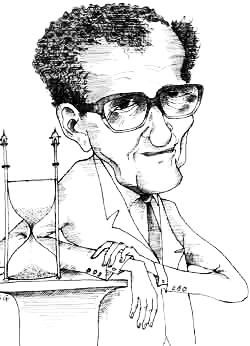
Amartya Sen proves that despite crop failure, there was nevertheless an adequate food supply in Bengal in 1943, though due to panic purchase, hoarding, military food storage and, above all, an economic boom that had raised food prices, it was mainly landless workers and the urban proletariat, whose wages had not followed the development, who could not obtain enough food. Bengali food production was admittedly lower than it had been the previous year, though more abundant than it had been in years befopre that, when no famine had occurred.
Amartya Sen’s studies of the Bengal famine have deepened in a way that proves him right in his conclusion that famines, generally speaking, are created by humans and can thus also be prevented, or at least mitigated, by humans. Archival studies have recently proven that Winston Churchill’s war cabinet in remote London had been repeatedly warned that a famine was brewing. At an early stage, the British Government was well aware of the fact that an excessive export of rice was likely to lead to a lethal famine, but it nevertheless chose to continue exporting undiminished quantities of rice from India to other parts of the Empire.

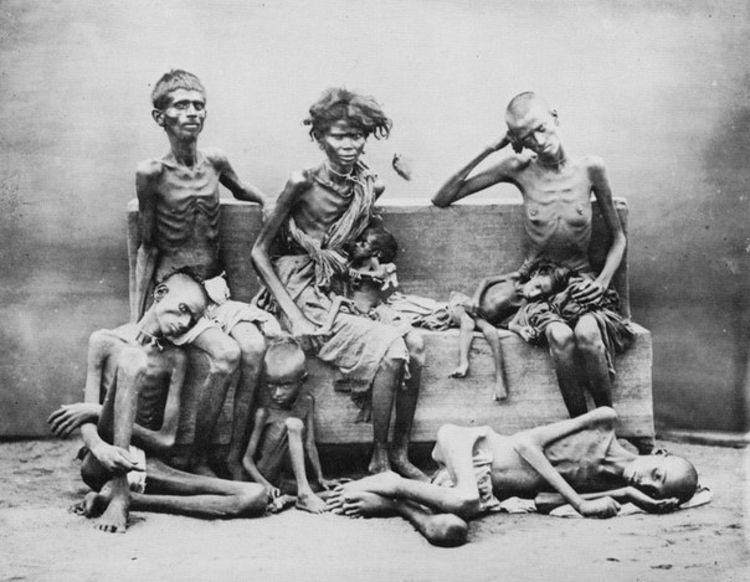
London turned a deaf ear when the Indians demanded a promised million tonnes of wheat in return for the exported rice. The warlords stood leaning over their maps and with a cigar in his mouth Churchill observed that the reason for the famine was actually that the Indians bred like rabbits and jokingly wondered that if the rice shortage was so immense, how come that Gandhi was still alive? The war was at the centre of these men’s thoughts and concerns, and in order to prevent the Japanese, who were approaching Bengal from Burma, from obtaining necessary food supplies, huge quantities of rice were brought away from the border areas, while thousands of boats were confiscated.

At the thought of Churchill and his associates leaning over their maps predicting and planning how the War would continue and unfold, I cannot help thinking of a poem by Anna Akhmatova, the undisputed poetess of the Soviet Union, who survived the siege of Leningrad, whose two husbands were executed and whose son spent more than ten years in Stalin’s Gulag camps. In a poem Akhmatova writes about the immense suffering behind figures, abstract data, figures and statistics:
I would like to call you all by name,
but the list has been removed
and there’s nowhere else to look.
I've woven them a shroud
prepared from poor words,
those I overheard.
I will always remember them, everywhere.
I will not forget them,
not even among new sorrows.

The cruel and emotionally cold attention with which leaders and rulers lean over maps, without a thought about the suffering they are causing through their hasty, strangely indifferent and yet fateful decisions.


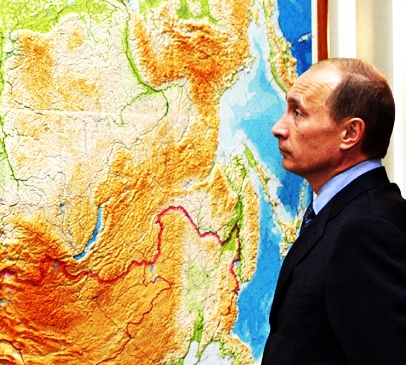
According to Amartya Sen, it is the inability of those in power, or even worse – their reluctance to act in the public interest by guaranteeing freedom for food producers, which cause mass starvation. Of course, Sen has been contradicted from various quarters, but I am convinced that he was right that it is people’s general reluctance to help each other that causes starvation and a lack of understanding that it is actually a fair distribution of resources that guarantees that our general welfare may protect us from war and famine.

Amartya Sen writes about the need for a ”new human psychology”, which continuously would take into account how
politics and psychology affect each other. People can indeed be expected to resist political barbarism if they instinctively react against atrocities. We have to be able to react spontaneously and resist inhumanity whenever it occurs. If this is to happen, the individual and social opportunities for developing and exercising moral imagination have to be expanded.

Deadly hunger is among the most degrading sufferings that may affect a human being. Paralysing hunger does not lead to rebellion. Most people plagued by an all-consuming hunger are forced into an animalistic, instinctive, all-encompassing quest for survival. During a famine, people experience months of indescribable suffering, weakened by hunger pangs that might lead to insanity, paralysis, and eventually death. Entire social systems are affected not only by food shortages, but lack of morals, ”decency”, and compassion. Crime, violence, and emotional insensitivity spread throughout the social body, being replaced by a ruthless struggle of all against all, a desperate battle for your own survival.

Inside the Gulag and the killing fields of the Stalin era, as well as in nNazi death camps and occupied territories, starvation reigned, paired with freezing cold, vulnerability and the fact that people died like insects around those still able to preserve a spark of humanity. Within that glimmer of compassion there could still be a flickering belief in your own and others’ love and compassion. When you were forced to give up everything you previously thought and hoped for, could you still care for others? Some tough indivuals beacme engaged in a struggle not to disappoint yourself and forget about others for the sake of your own survival. Some clinged to a hope that everything would come to an end, a belief that you would finally make it alive. That you, and maybe even your loved ones would mange to survive and overcome Hell with so much strength and dignity left that you could endure an effort to be able to live again. I think very few were privileged to receive such a grace. Those who could tell of a miracle were the those who had survived – they knew that a miracle was the only reason why they had not perished.

Not everyone pass through hunger and torment as if they were animals, though many, probably most of them, suffer severely from hopelessness, which in addition to physical pain force them into shame and despair. It is not without reason that cynical rulers might consider hunger to be an effective means of crushing their enemies, bringing reluctant subordinates to their knees, pacifying and paralysing them through hunger and despair. Hunger is a weapon for the powerful and a bottomless shame for the destitute.

When I worked at Swedish International Development Agency (Sida), I was by my colleagues asked to be helpful in arranging an entertainment for the Agency’s Stockholm staff. I jumped at the opportunity to perform a role I always had dreamed of impersonating – The Master of Ceremonies, MC, in Kandor’s and Ebb’s magnificent Cabaret. Together with my colleagues I created a number revue as if it were a more modern variant than the one presented at the Kit Kat Klub in Berlin and we sang and danced. Before that, I had several times watched Bob Fosse’s unforgettable film version and knew every song number by heart. My absolute favourite was and still is Money, Money! which includes the lyrics:
When you haven't any coal in the stove
And you freeze in the winter
And you curse to the wind at your fate
When you haven't any shoes on your feet
Your coat's thin as paper
And you look 30 pounds underweight
When you go to get a word of advice
From the fat little pastor
He will tell you to love evermore
But when hunger comes to rap
Rat-a-tat rat-a-tat at the window
(At the window!)
Who's there? (hunger) oh, hunger!
See how love flies out the door.

The musical takes place in 1931, two years before the great famine hit Ukraine. The beginning of a monumental bloodbath that once more would wash over the constantly disputed areas between the German and Russian/Soviet empires. Tormenting the inhabitants of areas which came to be called The Blood Lands. In Bolshevik Ukraine Amartya Sen’s views could impossibly be counter-argued. There, mass starvation was for sure caused and exacerbated by an undemocratic, entirely totalitarian policy.
Considering Putin´s intense propagandistic argumention that Ukraine is a Russian core country, it could be opportune to point out that for most of the time, before it was annexed by Russia during Catherine the Great in the 1780s, this disputed area had for centuries been divided and torn between Ruthenians, Poles, Muscovites, Mongols, Tatars, Turks, and even Swedes, while it was inhabited by Ruthenians, Russians, Jews, Roma/Sinti, Greeks, Germans, Italians, and Cossacks.
Before the Russians invaded the area with full force, it had since 1648 been largely dominated by the Zaporože Cossacks. Those denominated as “Cossacks” were groupings of warrior peasants , who at first probably mostly consisted of escaped serfs and slaves who over time became united with other people who had ended up in areas which in both Polish and Russian were called the “border areas” – Ukraine.
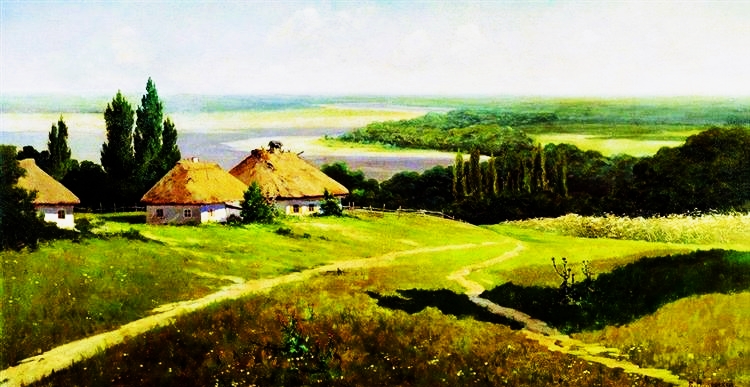
The Cossacks and other steppe inhabitants were most often “controlled” by the Polish Kingdom, in union with Lithuania, and several of these settlers were during certain time periods oppressed by Polish lords, who occasionally could join forces with the “free” Cossack hordes, especially during common struggles against the Ottoman Turks. The Poles were generally Catholics, while Cossacks were Orthodox. In 1648, the Hetman, Cossack leader, Bohdan Khelmelnysky, headed a revolt against the Poles. After winning the war, the Cossacks controlled the Ukrainian steppes under constant skirmishes with Polish and Russian armies.

During my book devouring youth I read with relish novels about 17th century Cossacks – Sienkiewicz’s With Fire and Sword and Gogol’s Taras Bulba, which I had found in my grandfather’s well-stocked library. Of course, while reading these thrilling novels, I did not discover their ethnic stereotypes, over-heated nationalism and gung-ho sentiments. Nor did I notice the nasty backdrop of Khelmelnysky’s uprising, i.e. the Cossack leader’s limitless hatred of the Polish szlachta, aristocracy, and the Jews, whom he considered to be the szlachta´s trusted henchmen and faithful servants.


Khelmelnysky’s bloodthirsty hordes killed an estimated 40,000 to 50,000 Jews, and when the peace treaties were concluded, all Jews were banned from living in territories controlled by the Cossack rebels.
However, it is doubtful whether the hatred Khelmelnysky’s Cossacks nurtured for Jews was actually, as their leaders stated, whipped up by the role of the Jews as tax collectors, it was rather due to religious fervour and the fact that the defenceless Jews turned to Polish overlords, since they actually represented protection and some security in an othjerwise often hostile and dangerous environment. I did not realize this until I read Bashevis Singer’s Satan in Goray, which dealt with the aftermath of Khelmelnysky’s massacres and how desperate and confused Jewish survivors found hope in the teachings of the “false Messiah” Sabbati Zevi. A mad world filled with a fanatically heightened anxiety and dybbuks, malevolent, evil spirits assumed to be able to possess people.

The Russian Civil War and the Polish-Soviet War of 1919-1921, portrayed by Ukrainian master tellers like Mikhail Bulgakov and Isaac Babel, were a disaster for Ukraine, resulting in 1.5 million deaths. Ukraine was also hit hard by starvation, though this time the epicentre was areas around the Volga basin. Between 1921 and 1923, five million people died, but unlike what was to come, Bolshevik leaders asked the global community for help. Lenin and Gorky wrote an open letter, appealing to “all right-thinking Europeans and Americans: 'Give us food and medicine'.” Through mainly the U.S. aid organization ARA, but also a number of European initiatives and 250,000 Russians, more than 10 million people were fed on a daily basis up until 1924.


When the hunger plague was over, people asked themselves: “Could anything be worse? Now, we expect that peace and prosperity must finally arrive.” Not at all.
Both Hitler and Stalin wanted to control of Ukraine’s fertile wheat fields. After World War I Germany had lost its – albeit much more modest than France and England – overseas colonies and had also been defeated in Western Europe. However, on the Eastern Front, German armies had in fact won The War, and before the Germans less than a year after the Brest-Litovsk peace agreement made with the newly founded Soviet Union, had been forced to relinquish their control over the vast tracts of land they had conquered, the Germans assumed that The East would provide them with Das Lebensraum, The Living Space, several of them longed for. Hitler and his followers continued to dream of populating Ukraine’s wheat fields with enterprising Aryans and their Slavic serfs. These abundant areas would feed the growing industry and working class in the Aryans’ western motherland.
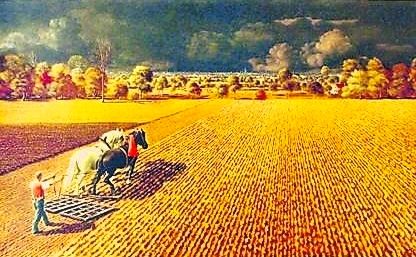
Stalin’s dreams were no less grandiose. For him Ukraine was much more than a source of agricultural supplies. It was a place that would change all economic laws. From there, the Soviet Union would be saved from poverty and isolation – an entire continent would be re-created. Nourished by the grain of Ukraine’s black soil, a vast army of industrial workers would build an utopian, high-tech communist Empire. Ukraine’s abundant surplus of wheat and cattle would be sold abroad and pay for what was needed to initiate a huge, amazing development.


Such enormous mobilization could not be allowed to be spoiled by half-measures and democratic squabble. No Polish parliament was required here, but goal-oriented, cold-blooded planning eould ransform every Soviet citizen into a cog in a well-oiled and relentlessly controlled machinery. But, how do you get a reluctant, bull-headed and stock-conservative peasantry to move in the right direction? Old believers who were appalled by the sight of a tractor factory, imagining that it was a Devil’s Fata Morgana.


Each and every peasant family could not be allowed to enrich itself on its own and to strive further along the same old plough furrows and linger in villages where family, church and neighbours were more important than a forward-looking collective, a progressive working class, science and a benevolent, rationally organized State. Everything must be aligend along the lines of Stalin’s thinking. Humans should be radically transformed, from being oppressed peasants down-trodden and sweltering under burdens of ancient farming methods, paralysing superstition and parasitizing big farmers. Agricultural labourers ought to straighten their backs and be offered education, access to scientific achievements and take their rightful place in emerging, effective collective farms and factories, like these young women working in a Donetsk factory:


But time for this transformation was limited. The Soviet Union was a huge country and in many ways backward, in particular if compaired to several of its increasingly threatening neighbours. Stalin feared the new nation’s arch-enemies, foremost among them Poland, which in 1921 against all odds had halted the Red Army’s advance towards the West. Furthermore, despite Lenin’s hopes to the contrary, Western capitalism did not seem to have weakened and Western democracies would not be crushed by revolting workers, at least not within any foreseeable future. Instead, there was according to Stalin a great at risk that his Soviet Union, wounded and weakened as it was by war and famine, was at a great risk of being attacked and subdued by Western, capitalist powers endowed with a far superior technology. In the East, another opponent grew stronger and constantly more threatening – Japan. In Stalin’s mental world, Western and Eastern spies, saboteurs and infiltrators threatened to corrode his Empire from within, while capaitalism/impeialism was mobilizing enemies all along its outstretched borders.

Massive industrial production and more efficient, modern agriculture collectives in the form of kolkhozy (if they were cooperative-run) or sovkhozy(if they were state-run) must be built up immediately, while reactionaries, saboteurs and spies had to be purged, exterminated and/or rendered harmless. One Ukrainian problem was the elongated, porous border with Poland and many Ukrainians often violent opposition to the Bolsheviks.
By the outbreak of World War I, large parts of the western and south-western parts of present-day Ukraine were an integrated part of the Austro-Hungarian Empire, meaning that when the Imperial Russian Army invaded Austro-Hungarian Galicia, 250,000 Ukrainians fought for Austria-Hungary, while 3.5 million were fighting on the Russian side and a huge number of Ukrainian civilians ended up in the cross-fire between the two huge armies.


Ukraine lost 1.5 million people during the war years and Ukrainian nationalists gained increasing support for their desire to unite “their people” within the borders of an independent republic, but such hopes were dashed when it in Versailles was decided that most of Ukraine would go to the Soviet Union and become one of its republics. Returning, war-weary soldiers, however, had previously gathered in Kyiv to participate in an All-Ukrainian Congress of Soldiers’ Representatives and on May 18, 1917, an Ukrainian General Military Committee was established with the task of organizing an “independent” Ukrainian Army. As commander for this army Symon Petliura (1879-1826) was chosen. He was a well-known journalist who mainly had been active in St. Petersburg. The Ukrainian language had since 1873 been banned throughout the Russian Empire and Petliura found it easier to write and operate in the capital of the Empire than in Ukraine.

However, quarrels within the Ukrainian leadership made Petliura leave the Government of a so far embryonic Ukrainian Republic and and take command of what now was called Haidama Kish, the “Voluntary Army”. During four years of fighting, Petliura fought both the Bolsheviks and the “White” forces opposing them, and he often sided with the Polish army. The Poles had assured Petliura that they supported an independent Ukraine.
Petliura’s tragedy was his undisciplined troops. Several of his soldiers were mentally war-injured veterans and although most of them were of peasant descent, their roots had been uprooted and most of them had lost contact with their relatives, if they had not died. Few had any professional background and the war had hindered them from getting a proper education. The soldiery lived under constant threat and were constantly in motion. Inadequately restrained army squads committed horrific crimes against the civilian population, especially Jews. All the armies that took part in the bloody civil conflict in Ukraine were guilty of murdering Jews, though Petliura’s Volunteer Army was definitely the worst. It is estimated that between 35,000 and 50,000 Jews were massacred during four years of Ukrainian civil war.


The pogroms could not be curbed. Petliura issued a stern order that the persecution of Jews and pogroms should be banned and forcefully condemned. Under no circumstances could such barbarism be tolerated, especially since foreign observers, not least the aid workers who had arrived in Ukraine to alleviate the famine and often were forced to observe the cruelty inflicted on the Jerwish population did not fail to report what they had seen and experienced.
Order issued on August 26, 1919, by the Main Command of the Armies of the Ukrainian National Republic: It is time to realize that the world’s Jewish population—their children, their women—was enslaved and deprived of its national freedom, just like we were. It should not go anywhere away from us; it has been living with us since time immemorial, sharing our fate and misfortune with us. I decisively order that all those who will be inciting you to carry out pogroms be expelled from our army and tried as traitors of the Motherland. Let the courts try them for their actions, without sparing the criminals the severest punishments according to the law. The government of the UNR, understanding all the harm that pogroms inflict on the state, has issued a proclamation to the entire population of the land, with the appeal to oppose all measures by enemies that instigate pogroms against the Jewish population.
Chief Otaman Petliura

The effort was in vain, mass rapes and pogroms against Jews continued. When Petliura lived in exile in Paris, he was in 1926 stopped in the street by an anarchist, Sholom Schwarzbard, who had had fourteen relatives massacred in a pogrom carried out by members of the Volunteer Army.
– Are you Mr. Petliura? Schwarzbard wondered and when Petliura waved his walking stick in confirmation, Swarzbard took a step forward and hissed:
– Dirty dog, my people’s killer. Defend yourself, and he then fired five shots straight into Petliura's chest.
Several of the Cossack units, which fought on all sides of the conflict, though mainly on the side of the Whites, particularly under the generals Kornilov, Alekseyev, and Deniken, were also guilty of horrific abuses directed against Jews. Even if they practised an inner discipline they were nevertheless often part of the demoralized and murderous groups which roamed the cities and the Ukrainian countryside in the early 1920s. A shocked eyewitness, an American aid worker wrote:
Around the the towns and shtetles are bandit packs, insurgents, groups, mobs, or simply peasants with pitchforks and scythes, with various slogans, with all sorts of demands, or with out all these gauze curtains [pretence]; – all of them beat, torture, mutilate Jews. There are many dozens of chieftains. Almost all of them have nicknames borrowed from the folk tales or pulp fiction.
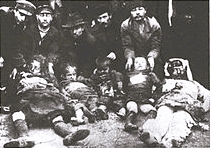
The Cossacks were a group in their own right. They were surrounded by a romantic nimbus and generally considered to be wild, reckless warriors. Exotic, yet well-known strangers. Unbridled, strong and uninhibited, they were nevertheless also known to be unwaveringly loyal to their Cossack comrades. Like the Red Indians of boys’ adventure books, they were considered to live in perfect harmony with their surrounding nature and rode as if they were one with their horses. It was not so strange that other groups, both criminal and nationalist, tried to imitate the Cossacks and often called themselves Cossacks and hetmans.
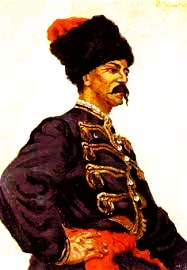


However, the genuine Cossacks, who lived in accordance with the traditions and specific rules of their clans and groups, would certainly not have identified with any particular “nationality”. Their identity lay elsewhere. They were “free men”, with traditions, ideas and laws of their own . Cossack identity was not based on any ethnicity, but on their community. Cossacks were not an ethnically homogeneous group of people and they did not identify with neither Russians nor Ukrainians.
Cossacks, like White officers, had similar motives for fighting the Bolsheviks. As a result of the revolution, they had lost their special privileges. The Bolshevik policy against Cossacks was quite simple – without any hesitations the new Soviet rulers declared that their aim was to dissolve the Cossack armies, while abolishing Cossack privileges and land ownership. Every attempt to maintain the traditional Cossack units was perceived as a counter-revolutionary activity and met with persecution and violence.


The Cossacks, who had made themselves known as excellent horsemen and devoted soldiers, had on their own terms made agreements with various rulers and often served directly under Russian tsars (when they did not rebel like Pugachev and Mazepa). For centuries Cossacks had retained their privileged status and generally hated the Bolsheviks’ attempts to curtail their freedoms, although one or two Cossack groups nevertheless sided with the Reds, such as some units within Semyon Bujonny’s cavalry army, which fought against the Poles and during World War II.

Enrolling in the Bolshevik forces could for some Cossacks be a matter of survival. Many suffered through their relentless refusal to submit to the Bolshevik State. Between 1918 and 1924, a large number of Cossacks were executed and even more were forcibly relocated. In the areas around Don, east of Ukraine, there lived in 1918, 4.5 million people, half of whom in villages granted specific Cossack privileges, three years later the population had more than halved.

In his novel And Quiet Flows the Don, Mikhail Sholokov, who was not a Cossack himself, gave a vivid and exciting fresco of the life of the Don Cossacks during the Civil War. In the novel, its hero, Grigory, changes sides again and again. Despite the straitjacket of social realism, the young Sholokov, who was only twenty-two years old when he wrote the first part of his quadrology, managed to give depth and relief to the characters his story and he also won Stalin’s enthusiastic approval. Sholokov was, in fact, one of the few persons who face to face with the life menacing and moody dictator dared to describe how a state-supported famine ravaged the Don area. In several letters he described to Stalin what was happening in the countryside during the worst crisis, between 1931 and 1932:
right now kolkhoz farmers and individual farmers are starving to death; adults and children are swelling and eating everything that humans are not supposed to eat, starting with carrion and ending with oak bark and all kinds of swamp roots. […] It is so bitter, Comrade Stalin! Your heart bleeds when you see it with your own eyes.
Sholokov even dared to criticise the arbitrary violence of political commissars and NKVD personnel: “We must put an end to the shameful system of torture used on prisoners.”
Stalin actually wrote personal replies to all of Sholokov’s letters. He pointed out that the young author went far beyond the boundaries of his writing by engaging in politics, something he did not understand. Nevertheless, to some extent, the dictator gave Sholokov some consent and even provided food supplies to areas in the author’s vicinity. Sholokov lived like an old-fashioned large estate owner, with servants and private estates. However, Stalin resented the empathy Sholokov felt for “our esteemed grain harvesters” most of whom, according to the dictator were schemers and saboteurs. It was something of a miracle that Sholokov escaped Stalin’s anger and persecution, The Father of Nations must have appreciated the young joker and boozer.

However, the dictator's stifling demands for a new, great epic about collectivization and an inability to repeat his previous performance made Sholokov sinking deeper and deeper into alcoholism and an embarrassing self-fossilization. However, he maintained an aggressive anti-Semitism and could even after Stalin’s downfall talk appreciative about the Stalin era. After such a laudatory speech, Sholokov found on one occasion that people in anger had thrown piles of And Quite Flows the Don outside of his door.
If my good friend and classmate Dan in high school had not given an unforgettable lecture on Quite Flows the Don I would for certain never have read the novel, but I did so with great interest and still remember several scenes, perhaps supported by a popular TV series that also was presented in my youth.

After the great famine of the early 1920s, the previously strictly controlled markets had reopened to individual sellers and the State’s pressure on the peasants eased, but as Stalin felt more secure in the saddle, his megalomaniac plans for mass production began to take shape and blossomed into the first five-year plan, between 1928 and 1932. When peasants proved reluctant to invest in kolkhozy agriculture and tractor depots, while agricultural production declined rapidly instead of increasing, Stalin gave the OGPU, United State Political Directorate i.e. the security police, the task of mapping property conditions in all of the Soviet Union in order to identify hamsters, speculators, profiteers and saboteurs. A witch hunt on so-called kulaks, fists, began, this was a nickname for rich, stingy farmers. In the Stalin era, kulaks became synonymous with farmers who refused to abandon their farms to join the kolkhozy. Even if kulaks were consistently portrayed as greedy parasites that sucked the life blood out of their peasant neighbours, the torrent of abuse and exaggerated propaganda thrown on these people, who mostly tried to secure the livelihoood for their families and thus had uttered some opposition to the the draconic methods of the Soviet commisars, seldom had any equivalent in reality.


In 1929, Stalin declared that the kulaks would be “liquidated as a class” and be divided into three categories: i) to be eliminated immediately; ii) be interned in labour camps and iii) 150,000 households to be deported as soon as possible. Speaking of liquidation, it was a word that had already been an integral part of the violent Bolshevik vocabulary, ever since the party took power in 1917, and for many of those persecuted by State and Party, its symbolic hammer and sickle came to signify not only the tools of workers and peasants, but a murderer’s sledgehammer and the Grim Reaper’s scythe.



Even the red-kerchiefed Mother Russia of Soviet propaganda could be turned into a Messenger of Death armed with a scythe.


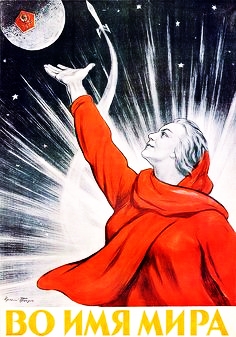
When the New York stock market crashed in 1929 and was followed by a prolonged and profound depression, many left-wing sympathizers came to believe that the Soviet Union had escaped the death trap of capitalism and that the Workers’ Republic would now sail past the hopelessly corrupt and degenerate West. Stalin’s propaganda machinery was not late in depicting his Socialist Empire, not to be filled with milk and honey but with wheat and tractors, like a Paradise on earth.


Protected not only by weapons, but also by its abundant harvests feeding the people of the Soviet Union and they could thus also be considered as an effective weapon of defence against the Soviet Union’s many enemies.


At the same time, the weeds had to be uprooted. Already in the first four months of the 1930s, 113,637 people had been transported away from Ukraine under the pretext that they were kulaks. Soon, 300,000 Ukrainian kulaks had been transported from Ukraine alone, to settlements and labour camps in the European part of Russia, in Siberia and in Kazakhstan. Labour camps were located to palces like Solovki, an archipelago in the White Sea, or Belomor, the centre of the 170,000 slave labourers digging through stone and frozen soil, as well as blasting a canal between the Baltics and the White Sea. After 20 months of suffering and death (the estimated number of deaths ranges from 12,000 to 25,000, mainly caused by acute starvation), the canal proved to have been a quiet unnecessary endeavour, it was to shallow for larger vessels and was frozen during more than half of the year. In Kazakhstan, hundreds of thousands had already died, after nomads had been forced to slaughter their herds during State attempts to turn the Kazakhs into resident farmers, a suffering increased by an influx of hundreds of thousands deportees.

In Ukraine, conditions worsened. The traditional leaders of the peasant collectives had been branded as kulaks, killed or deported and most villages were in a state of dissolution. The remaining and increasingly poor farmers were through taxes and requisitions of their livestock and crops forced to join the collectives.



The 1931 harvest was miserable, not at all as abundant as the year before, which had been used to set the 1931 quotas. The weather was bad, cattle had been slaughtered, the tractors were not as efficient as expected and the state demanded grain for export and to feed a rapidly growing industrial working class. However, the authorities could not bring themselves to regret or amend their failed agricultural policies. The misery was blamed on kulaks, hamsters, saboteurs and foreign infiltrators, mainly Poles.

It was impossible to fill the quotas, but the State insisted that they must be fulfilled. Energetic OGPU men were sent out to search for hidden wheat and meat, and in their madness the authorities even sent away next year’s seeds. A frightful disaster could not be avoided. During the summer, people in Ukraine were reached by rumours that more one million had already died of starvation in Kazakhstan and soon death was everywhere in Ukraine. The madness grew in scope. In November 1932, it was decreed that those agricultural collectives that did not deliver their quota on time would be sentenced to increase it even more, as soon as possible. No respite was given, the grain had to be delivered in quantities determined by the State, if more time had been given perhaps more grain could have been produced, but now it was impossible. The borders were closed, train tickets and internal passports were denied to Ukkraine’s rural population, an action declared to be an attempt to curb a “counter-revolutionary plan” which, according to the authorities, was trying to “expose misleading pictures and reports of hunger and poverty to outsiders.”

Some brave reporters managed to photograph corpses that lay scattered in the streets of Ukrainian cities, before being picked up. Particularly painful for the few visitors and travellers who managed to enter the sealed-off Soviet republic was to be confronted by large hordes of orphans, as well as desperate mothers who asked passers-by to take care of their dying, emaciated babies. Parents often died of starvation before their children and orphans were crowding train stations, kolkhozy and factories. Several were captured as if they had been wild dogs and taken out of sight to “orphanages”, which also lacked food and where the children died.



One of the few who, under strong opposition from the Soviet authorities and the outcry of the Soviet Union’s global acolytes, managed to publish articles and photographs from a hellish journey through a famished Ukraine was the brave, Welsh and Russian-speaking journalist Gareth Jones. Two years after the publication of his startling articles, Jones was in Manchuria apparently kidnapped and murdered on behalf of the NKVD (the organization that in 1934 had succeeded the OGPU).


By early 1933, the Ukrainian countryside had became mute and silent. Anyone who is familiar with a lively farmland can easily recall its symphony of sounds and how the air carries them far and wide – roosters’ crows, dogs barking, chickens cackling, noise from pigs and ducks, people’s songs, cries and loud voices, children’s laughter and screams, birdsong from thickets and rooftops. Even the politicians who come to find hidden foodstuff and arrest “opposition elements” testified how they had ended up in a strange, extremely eerie world. Unburied corpses were strewn on paths and village streets, but worst of all was the confrontation with emaciated people still alive. On their alternately shrunken, alternately swollen, sore bodies, the skin was tightened over bone knots and ribs, so thin that it seemed to be made of paper, or as if the starving victims had become transparent. The heads of adults and children seemed to be unnaturally large, their necks elongated; legs and arms like sticks, stomachs swollen with skin tense like drum skins and everywhere abandoned or extinguished glances, an almost unbearable silent suffering. If one of these creatures, which appeared to have come from another planet, got something to eat, it often happened that they died shortly thereafter. Their altered organisms had not been able to cope with the shock of nutritional supplement.
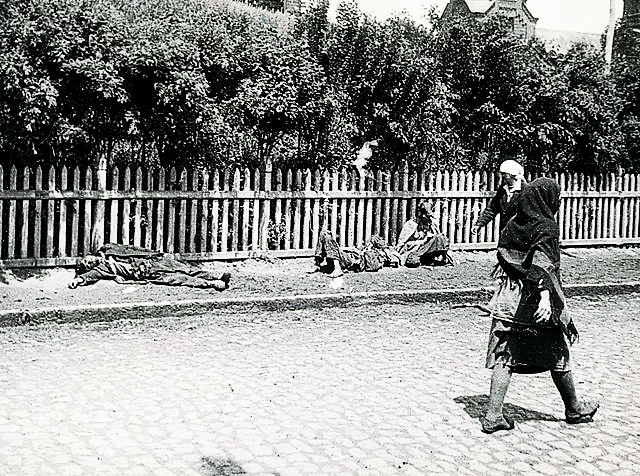
By extreme hunger, the body cannibalizes itself. It swallows its glucose, fat, tissues, meat and proteins, even the skin is sucked out and shrinks, eyes protrude from their cavities, all power disappears from the hungry, while the immune system collapses and diseases take hold of external and internal organs.
In the midst of all these indescribable torments was the presence of a state-sponsored absurdity which meant that while the outside world was kept unaware of what was going on, food was not brought to the needy, but instead taken away from them, while starvation victims were accused of their own desperate condition, being stamped as traitors, saboteurs, hamsters, and reactionaries. They were even punished, executed, or deported and forced to try to survive in extreme cold or heat. An example of the absurdities that occurred:

Ukrainian musician Yosip Panasenko and his band of bandura players were engaged by the authorities to “bring culture to the starving.” They found village after village totally deserted. In one place they entered a house and found two girls lying dead in a bed, a dead man’s legs protruding from the oven, a mad woman crawling on her knees, scratching the floor with her nails.
The bones in the stove testified to a terrible reality that already had existed during the famine in the early 1920s, but then the shock had been great and authorities had carefully documented what happened, photographed, interviewed and recorded, while the outside world was made aware of the terrible truth – cannibalism. One of humanity's greatest taboos and a source of shame and despair.

Reports of cannibalism was not published in the 1930s. It was not until long after the Holodomor (holod - famine, mor - plague) that it was discovered that the authorities had actually registered widespread cannibalism and that in 1933, 2,505 persons had been convicted of cannibalism, the actual perpetrators were for sure many more.

The estimated figure for Ukrainian deaths during the Holodomor (1932-1933) is 3.3 million, while at the same time 67,297 died of starvation in the labour camps and 241,355 in the settlements to which kulaks and their families had been deported. Thousands also died during travels to these places in distant Siberia or Kazakhstan, several, perhaps most of them, were Ukrainians.


The deported kulaks who between 1930 and 1933 ended up in Kazakhstan came from one killing field to another. Kazakhstan had in 1928 been hit by the Zhut, a period of extreme cold that prevented cattle from finding pasture and thus forced to starve to death. The Soviet authorities saw their chance to confiscate surviving cattle from richer Kazakhs, who here were not called kulaks but bai (chiefs), and at the same time convince other Kazakhs of the benefits of joining an agricultural collective.
More than 10,000 bai were deported from their homeland, after losing their land and livestock. Between 1929 and 1932, the Soviet state seized most of Kazakhstan’s livestock and grain. One third of the grain, one million tonnes, was distributed to the urban population. However, the Kazakhs starved mainly because meat production became insufficient and then 200,000 “settlers” and former Gulag prisoners were brought to the Soviet republic to become engaged in agriculture, part of the already scarce Kazakh food production went to them. Meanwhile, tens of thousands of Kazakhs were expelled from their pastures and plots of land.

The Kazakh famine became the worst of the Soviet famines. More people died in the Ukrainian Holodomor, but Kazakhstan lost through Soviet interventions approximately half of its population – 1.5 million, of whom 1.3 million were Kazakhs, the rest had been forcibly deported from other places in the Soviet Union. 665,000 Kazakhs fled with their livestock, mainly into China, Mongolia, Afghanistan and Iran.


The Soviet leader who oversaw Kazakh tragedy was Philip Goloshchyokin (1876 - 1941), originally a dental technician from Nevel situated by the northern border to Belarus, though he soon became a professional revolutionary, going in and out of prisons. For a time he was also deported to Siberia. Goloshchyokin co-founded the Russian Communist Party (the Bolsheviks) and after its coup in 1917 he became Military Commissioner of the Urals, stationed in Yekaterinburg (Sverdlovsk) where he took the initiative and carried out the execution of the Tsar and his family.

In February 1925, Goloshchyokin was appointed First Secretary of the recently established Kazakh Autonomous Socialist Soviet Republic and served until 1933 as the republic’s autocratic ruler. It was under the supervision of Goloshchyokin that the fatal collectivization took place. Those who knew Goloshchyokin have described him as a cold cynic, distanced from his subjects:
This is a typical Leninist. This is a man who does not stop the blood. This trait is especially noticeable in his nature: the executioner, cruel, with some elements of degeneration. In party life he was arrogant, was a demagogue, a cynic. He did not count the Kazakhs as people at all. Goloshchekin did not have time to appear in Kazakhstan, as he stated that there is no Soviet power, and it is “necessary” to orchestrate a “small October” [Bolshevik coup].

Numerous complaints concerning Goloshchyokin reached Stalin, though he let him stay on while listening to his assurances that the five-year plan and collectivization were a success. Quite unexpectedly, however, Goloshchyokin was brought back to Moscow in 1933, where he served in a more secluded post as arbitrator at the USSR Council of Commissars, where he remained untouched until 1939, when the head of the NKVD, Nikolai Ivanovitj Yezhov, Stalin’s “bloody little dwarf”, was ousted. Before Yezhov was executed, he had during prolonged torture produced a large number of “confessions”, revealing among other things that he and Goloshchyokin were lovers. Homosexuality had been criminalized in 1934, and it was probably that inclination, and neither mass murder nor the promotion of mass starvation, that led to Goloshchyokin’s eventual execution.

It is quite clear that Stalin was convinced of Yezhov’s guilt of conspiring against him, a conviction fuelled by Yezhov’s successor, the equally sinister Lavrentij Berija. Whether the perverted extravagances of “the bloody dwarf”, with both women and men, were also decisive for the execution of Goloshchyokin, is however not entirely certain. Stalin was admittedly in many ways a priggish Victorian who hated exposure of open eroticism and sincere tenderness, though in an inner circle of vulgar comrades he did with relish shoulder the role of a brutal macho guy. Stalin often expressed his contempt for homosexuals, his common denomination of them was “the degenerates”. However, he was far from ignorant of, tolerated, and used for his own purposes all the “high tension” and promiscuity that prevailed among people within his inner circle. An uninterrupted nervousness mixed with an intoxicating power over life and death, which made the privileged few believe that they were exempt from generally accepted morals and human considerations, while at the same time they were engaged in a dynamic tumult where people rose, fell and disappeared. One day you could be exalted and praised, only to be tortured the next day in a blood-soaked NKVD cellar and later dragged out into a secluded court yard and receive a bullet in the back of your head.

Within this psychotic constellation of power and guilt it was not uncommon that the same actors constantly appeared in close proximity to each other. In Yezhov’s case, for example, the strangely untouched “Cossack author” Sholokov seems to have played an important role. Like several other writers, he had had been in an intimate relationship with Yezhov’s equally promiscuous wife, Yevgeniya. Yezhov had been eavesdropping on Sholokov and hadf him constantly shadowed. The angered author went straight to Stalin, complaining about the greediness and promiscuity of Yezhov and presented everything he had heard about the NKVD chief’s irregularities. Instead of defending the man he met at an almost daily basis to establish executions and plan torture, Stalin assured his good writer friend Sholokov that he was already disappointed with Yezhov and that all the crimes he was suspected of having committed would be thoroughly investigated.


Stalin’s openness to Sholokov is astonishing. The alcoholic writer had even on several occasions been observed telling Stalin that he considered it to be unworthy of a man of his stature to accept the ridiculous cult directed towards him. On such an occasion, Stalin had, with one of his famous “foxy smiles” playing under his moustache, replied: “The people need a God.”


There is no doubt that after Yezhov’s execution, Stalin completely obliterated his memory. For example, we see below, as often was the case, Yezhov by Stalin’s side, this time during a walk along the Moscow-Volga canal in 1937. Stalin obviously liked the photograph and a year after Yezhov’s disgrace and execution it was included in a tributary biography of the great leader, but then Yezhov had disappeared from the picture without a trace.

While all this was going on in the Kremlin, the Soviet people continued to suffer. War, famine, poverty, violence, plagues, pogroms and state oppression had not created any utopian society in the Soviet Union. It was possible to blame sinister foreign powers, people’s general unwillingness to work and anti-Bolsjevik sabotage, but it could not be denied that something had gone catastrophically wrong. Not least, everyone could be reminded of the misfortunes through the presence of hundreds of thousands of stray, orphaned children. The aid organizations that operated in the country in connection with the famine 1921 to 1923 estimated that through their and government efforts, five million children under fifteen years of age were on a daily basis provided with food, many of them were certainly not orphans, but those children who were completely defenceless nevertheless amounted to hundreds of thousands, with everything it meant of unimaginable suffering and in many cases emotional and physical exploitation.


Many writers and journalists pointed out the constant presence of those vulnerable children, and some artists, such as the somewhat murky, though officially appreciated Fyodor Bogorosky, became in the 1920s known for their portrayals of besprizornye.


Bogorosky was later banned from portraying the victims of such poverty and abuse and like so many other artists he went on to create charming park landscapes and heroic social realism.


It seems that in Soviet society there was a parallel world of extreme poverty, crime and lawlessness. It was denied in official propaganda, generally ignored by artists and writers and it was probably even forbidden to seriously portray misery in an empathetic way, as it had been done before the revolution, for example by Maksim Gorky in his once world-famous play The Lower Depths.

Some grotesque and strange scenes in Sergei Eisenstein’s film The Strike from 1925, does however suggest the presence of a criminal world, in the midst of big Soviet cities. A police spy seeks out a gangster boss who with his large retinue resides in a cemetery. The whole thing is played out as a kind of farce, a bizarre and actually rather disgusting pantomime, like a social realistic overplayed Commedia dell Arte. The gangster appears as a kind of vaudeville tramp, once a common trope in music halls and movie sketches. He is courted by a submissive dwarf and “his people” living in large barrels, buried and lined up in a field, or under gravestones. They are portrayed as obscenely absurd and hardly human beings, a lumpen proletariat which willingly lends itself to spoiling the workers’ attempts to obtain decent wages and working conditions. Even if Esienstein describes it all as taking place during the old, wretched tsarist era, it nevertheless has a contemporary touch to it.

Until the end of the 1930s, few extensive attempts were made to take care of the enormous crowds of suffering, orphaned children, other than that they were roundwed up, sent to collection sites and deported to various places within the vast Soviet Empire. It was not until 1937 that the State more systematically began to take care of children of sentenced “enemies of the state”, i.e. criminals and/or subversive “political elements”, who had been executed or deported.

Abandoned children are still present in Russia. It is estimated that there may cu7rrently be at least 50,000 besprizornye in the country.

We should not assume that Ukraine’s suffering ended after the Holodomor and the purges of the Poles. For several years it continued unabated. When the harvests could finally be salvaged again, the collectives were made more efficient and the harsh quotas in 1937 could be met, the persecution of kulaks took off again. Between 1937 and 1938, 70,868 Ukrainians were liquidated by the NKVD, only between January and August 1938, 35,563 were shot, while “only"” 830 were sentenced to labour camps. At the same time, 40,530 Ukrainians accused of “nationalism” were arrested.


In the midst of all this those who had suffered from hunger and hardship tried to pursue what they had lacked; life’s simple joys—especially food.

However, an abundance of food and delicacies had never been lacking at Stalin'’ sumptuous dinner table, which naive and easily impressed VIP visitors perceived as a result of the abundance created by the prosperity of the Workers’ Republic.


For example, when the celebrated author George Bernhard Shaw in 1931 visited the Soviet Union during the impending famine of Ukraine and Kazakhstan, he was in Moscow greeted by a military guard of honour, banners adorned with his portraits and crowds shouting “Long live Shaw!” A sumptuous banquet was organized to celebrate Shaw’s 75th birthday and afterwards he was treated with a two-hour conversation with a Stalin who Bernard Shaw found to be in a “charmingly good-humoured mood.” A greatly satisfied Shaw left Moscow after nine days. The day before his departure he gave a good-bye speech ending with the words: “Tomorrow I will leave this land of hope and return to our western countries – the countries of despair.”

When Germany’s Sixth Army and First Armoured Corps on June 22, 1941 broke through the Soviet Union’s Fifth Army and invaded Ukraine. The astonished Germans were in several places met by cheering people throwing flower bouquets at them. These Ukrainians assumed the German armies would free them from the Communist terror. They could hardly imagine what awaited them.

During its lightning offensive, called Operation Barbarossa, the German army captured about five million Soviet soldiers, most of whom were deliberately starved to death. This was done in accordance with a so-called Hunger Plan. Between 3.3 and 3.5 million captured Russian soldiers died in German detention camps, most of them from starvation.


Shortly before the invasion of the Soviet Union, Herbert Backe, State Secretary at the Ministry of Trade and Industry, did at the Chief of German Police and Minister of Interior, Heinrich Himmler’s request, in coperation with a coalition of Nazi politicians, draw up a plan to secure Germany’s future food supply. One month before the initiation of Operation Barbarossa, Backe’s plan was presented to Die Oberkommando der Wehrmachts, the Defense Staff’s, finance office, which enthusiastically approved it while emphasizing the Soviet railway network’s deficiency, insufficient road transport and fuel shortages which the German army was going to encounter in conquered areas.

The following conclusions were drawn: i) the war can only be fought if Russian supply is guaranteed for three years, and ii) this undoubtedly means that tens of millions of Russians will die of starvation, a “logical and inevitable development”. It was further stated that “tens of millions of people will become redundant” and thus had to die or being forced to emigrate to Siberia. Any attempt to save locals from starvation would prevent Germany from emerging victorious from the apocalyptic battle.


Ukraine’s perceived grain surplus was particularly prominent in this vision of a “self-sufficient” Germany. Hitler had stated that Germany needed “Ukraine, so that no one could be able to starve us again, as they did during the last war.” In order for Germany to “take advantage” of Ukraine's agricultural surplus, it was necessary that “undesirable elements”, such as Jews and the Ukrainian town population, be completely denied any food supplies, while food rations for rural Ukrainians should be limited as much as possible.
Backe estimated Russia's “surplus population” to be between 20 and 30 million, if these people were denied food supplies, these could be used for the German army and the German population. A carefully planned famine would thus be an integral part of the German military campaign and would henceforth be a solution to the European food crisis, as well as an effective method of eradicating an “undesirable” Soviet population.

Germany’s attack on and occupation of Ukraine killed at least 2.5 million soldiers and 4.5 million civilians. More than 2.2 million Ukrainian civilians were taken to Germany as slave labour, less than half of them returned, the others had fallen victim to Allied bombings and German mistreatment.
The Nazi genocide in Ukraine was directly linked to the Vernichtungskrieg, War of Extermination, outlined in connection with the aforementioned Hunger Plan and was directly linked to the German army’s conquest and subjugation of Ukraine.

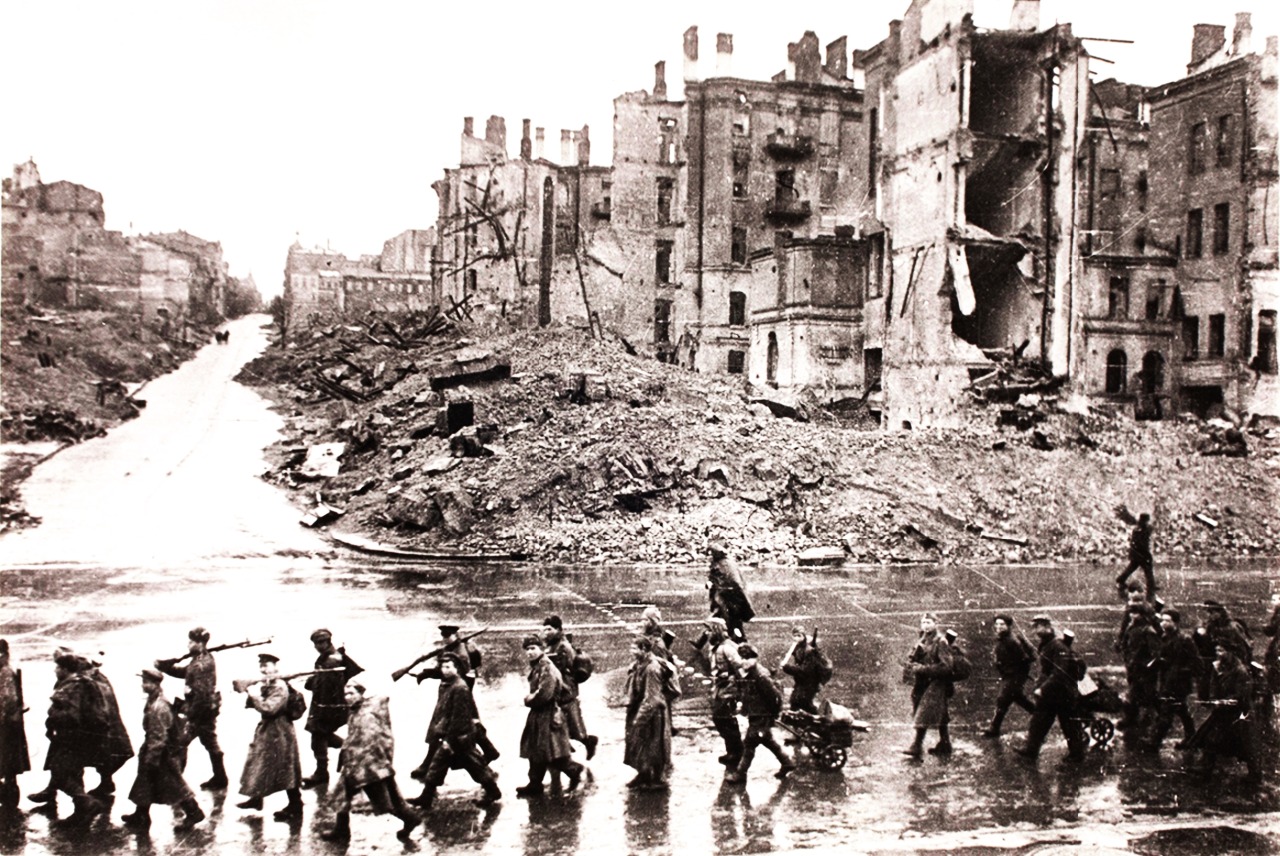
More than four million Ukrainian civilians were killed during the German occupation, including more than one million Jewish victims. Defenceless men, women and children were ruthlessly slaughtered by German Einsatzgruppen, police battalions, Wehrmacht troops, Romanian army units and local Nazi collaborators. Einsatzgruppe C (Otto Rasch) was assigned to northern and central Ukraine and Einsatzgruppe D (Otto Ohlendorf) carried out its mass executions in Moldova, southern Ukraine, Crimea and northern Caucasus.

The most extensive massacre took place in the Babij Yar ravine just outside of Kyjiv. The site was chosen for several mass executions and a total of 100,000 people are estimated to have been slaughtered there. On September 28, 1941, Kyjiv’s German military command announced that all of the city’s Jews had to be evacuated. They should show up at the train station, bringing warm clothes, personal documents, money and valuables. Between the 29th and the 30th of September, 33,771 men, women and children showed up and were transported to the extensive ravine eight kilometres outside the city. Upon arrival they were forced to undress, before being mowed down with machine guns, only two women escaped and survived the horrific massacre.

The main person responsible for this mass slaughter of innocent civilians was SS Brigade Commander Emil Otto Rasch, commander of Einsatzgruppe C. Dr. Rasch had received his doctorate through a dissertation in jurisprudence and political economy. A dutiful man who believed that a commanding officer had to be present at executions of Jewish men, women and children. Rausch was arrested shortly after the war, but was not questioned, convicted or executed since he was diagnosed with advanced Parkinson’s disease, combined with dementia. He died in his cell in 1948.

The leader of Einsatzgruppe D, Otto Ohlendorf, who was arrested together with Heinrich Himmler in Flensburg, was able to give a number of testimonies. Ohlendorf was completely incorrigible, during the Nuremberg trial he claimied that he had acted as a dutiful and correct German officer:
It was not a racist programme for the annihilation of Jews in the Soviet Area but a general liquidation order primarily aimed at securing the newly won territory, a liquidation that would affect not only the Jews, but other population groups as well. […] the tasks of the firing squads were no worse than those of the “press-button killers” who dropped the atom bomb on Japan. […] the aim was that the individual leaders and men should be able to carry out the executions in a military manner acting on orders and should not have to make a decision of their own; it was, to all intents and purposes, an order which they were to carry out. On the other hand, it was known to me that through the emotional excitement of the executions ill-treatment could not be avoided, since the victims discovered too soon that they were to be executed and could not therefore endure prolonged nervous strain. [However] all ill-treatment, whether pysical or mental, was to be prevented through measures ordered by me.

While given his testimony, Ohlendorf did not show no remorse whatsoever:
Because to me it is inconceivable that a subordinate leader should not carry out orders given by the leaders of the State.
Leon Goldensohn, the psychiatrist who interrogated Ohlendorf with the task of “presenting a psychological profile” of the war criminal, stated that Ohlendorf:
looks like a burnt out ghost and his conscience, if you can call it that, is shiny clean and completely meaningless. The lack of affect is obvious, but not remarkable in the clinical sense.
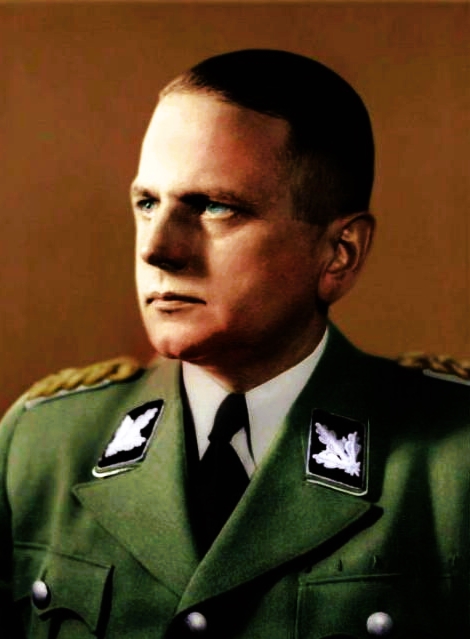
Ohlendorf was sentenced to death for crimes against humanity and hanged in 1951. The Russian poet Yevgeny Yevtushenko did in 1961 write a poem about Babij Jar, some lines from it:
The wild grasses rustle over Babi Yar.
The trees look ominous,
like judges.
Here all things scream silently,
and, baring my head,
slowly I feel myself
turning grey.
O my Russian people!
I know
you
are international to the core.
But those with unclean hands
have often made a jingle of your purest name.
Putin! Of course, you cannot hear a voice as insignificant as mine. But… I'm asking you anyway. Did you forget this? Have you forgotten the blood that was flushed over Ukraine? All the suffering, all the death and how much of this misery was caused by your percursors? I read your compatriot Yevgeny Yevtushenko, as well as Gogol, Turgenev, Chekhov, Tolstoy, Dostoevsky, Akhmatova, Pasternak, Mandelstam, Bulgakov, Grossman and say onto you: “Shame on you!” You are declaring that you are saving Russians, that’s a lie, you’re dragging their name, their inheritance, their pride in the dirt – your unclean hands have made a jingle of their pure name.
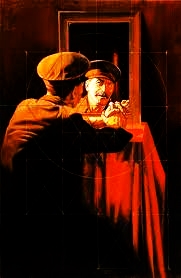

Applebaum, Anne (2017) Red Famine: Stalin’s War on Ukraine. London: Penguin Books. Astashkevich, Irina (2018) Gendered Violence: Jewish Women in the the Pogroms of 1917 to 1921 (Jews of Russia & Eastern Europe and Their Legacy). Boston MA: Academic Studies Press. Boeck, Brian J. (2018) Stalin’s Scribe: Literature, Ambition, and Survival; the Life of Mikhail Sholokov. Winnipeg: Pegasus Books. Cameron, Sarah (2018) The Hungry Steppe: Famine, Violence, and the Making of Soviet Kazakhstan. Ithaca NY: Cornell University Press. Czapski, Józef (2018) Inhuman Land: Searching for the Truth in Soviet Russia 1941-1942. New York: NYRB Classics. Hilberg, Raul (1985) The Destruction of the European Jews. New York: Holmes & Meier. Mecacci, Luciano (2019) Besprizornye: Bambini randagi nella Russia sovietica (1917-1935). Milano: Adelphi. Rayfield, Donald (2004) Stalin and His Hangmen. London: Penguin Books. Sebag Montefiore, Simon (2014) Stalin: The Court of the Red Tsar. London Weidenfeld & Nicolson. Sen, Amartya (1982). Poverty and Famines: An Essay on Entitlement and Deprivation. Oxford: Oxford University Press. Sen, Amartya (2000) Development as Freedom. New York: Alfred A. Knopf. Sen, Amartya (2006) The Argumentative Indian: Writings on Indian Culture, History and Identity. London: Penguin Books. Snyder, Timothy (2011) Blood Lands: Europe Between Hitler and Stalin. London: Vintage. Yevtushenko, Yevgeny (1991) The Collected Poems 1952–1990. Edited by Albert C. Todd with the author and James Ragan. New York: Henry Holt and Company.


.jpg)
.jpg)
.jpg)
.jpg)
.jpg)
.jpg)